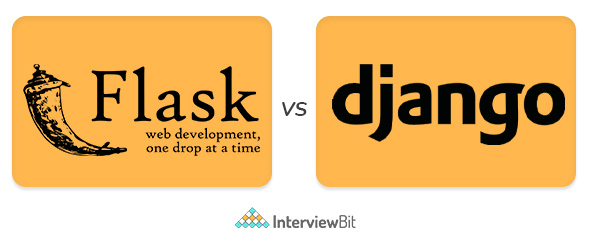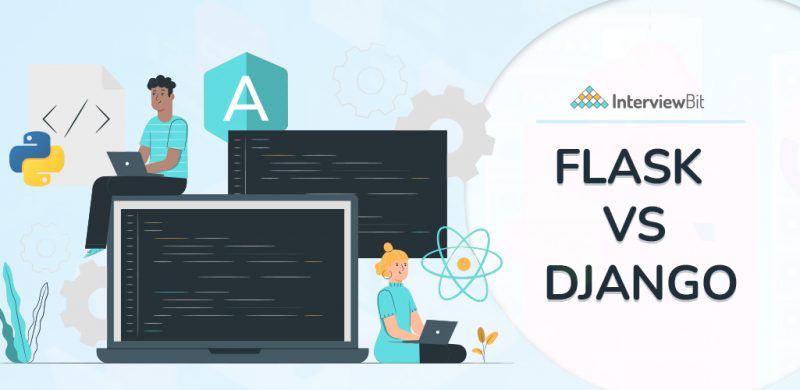- What is Django?
- What is Flask?
- Python Flask vs Django: Tabular Difference
- Django vs. Flask: Which one is better?
- Flask: Pros and Cons
- Django: Pros and Cons
- Conclusion
- FAQs
- Q.1: Is Flask easier than Django?
- Q.2: Which is better Django or Flask for beginners?
- Q.3: Is Django front end or back end?
- Q.4: Why is Flask preferred over Django?
- Additional Resources
The Python programming language comes with a wide assortment of web frameworks that can be used by web developers to build websites. This allows the web developer to choose the framework that most closely fits their task and is most suitable for the endeavour. Among many popular choices, Django and Flask are the two that are most often compared in order of popularity. Most likely, this is the result of both of them sharing some similarities and many differences. Each framework has its own unique features, so we can use it in accordance with the requirements of a particular project. As a full-stack web framework, Django is best suited for developing large and complex web applications, while Flask is a lightweight, extensible framework that allows you to develop small web applications. With Django, you will enjoy the batteries-included approach and have access to the most comprehensive functionality.
Are you still unsure which framework to use for web development? Even though each of these web development frameworks has its own unique features, there are many factors that you should consider before choosing one for your application.
What is Django?
Created by Adrian Holovaty and Simon Willison in the year 2003, Django is a Python-based open-source framework for designing web applications. It is a high-level web framework that is built to make the web development process faster and more efficient. Inspired by many of the old frameworks like CherryPy, Zope, Plone, etc. Django is a free source with enhanced features and better performance. Developers choose Django because it enables them to use it for standard functionalities with a limited interference of systems, protocols, and management.
Confused about your next job?
Django is also called a ‘framework for fussbudgets with deadlines’ as its framework encourages rapid development and clean, pragmatic design. The agile development process of the framework aims solely to provide quality with rapidness and efficiency. Django deals with some of the basic development functions quickly like site maps, content organization, client information, and, so many more. It just focuses on finishing the application as quickly as possible.
Companies Using Django
Django is used by the following giant companies:
- Coursera
- Mozilla
- National Geographic
- Spotify
- Udemy
- Zapier, etc.
Key Features: Django
Some of the key features of Django are as follows:
- Fast: It is insanely Fast. Without any thought, the Django working process from concept to completion is extremely fast.
- Versatile: Django is a versatile framework that enables developers to work on different platforms varying from content management systems like WordPress, etc., to social network sites like LinkedIn, Youtube, etc., to news sites like The New York Times, CNN, etc.
- Adaptable: Django is adaptable to different formats like JSON, HTML, XML, and many more.
- Scalable: It is a framework that ensures scalability ( a system that allows making changes in different layers and updations without much cost and effort i.e., every layer is independent) and maintenance (the design and code are not susceptible to duplications and, hence, the code can be reused and maintained properly)Secure: Django guarantees security with powerful authentication systems and protocols to avoid clickjacking, unauthorized access, cyberattacks, etc.
- Portable: Django is a Python-based framework and, therefore, portable.
What is Flask?
Flask is also a Python-based microframework that is used for web application development. It was introduced by Armin Ronacher in the year 2011 as a trial method of joining two solutions i.e., Werkzeug (a server framework) and Jinja2 (a template library).
It was supposed to be a trial run in a zip file that ultimately originates from the positive influence of Flask.
Flask is categorized as a micro framework because it does not depend on external libraries to perform the tasks of a framework. It has its tools, technologies, and libraries to support the functionalities of web application development.
Since this framework is more independent and flexible, many developers prefer to start with Flask.
Companies using Flask
Flask is used by the following giant companies:
- Netflix
- Airbnb
- MIT
- Lyft
- Zillow
- Mozilla
- MailGui, etc.
Key Features: Flask
Some of the features of Flask are:
- Lightweight: It is a lightweight framework as it is independent of external libraries. It gives a quick start to the web development process of complex applications.
- Independent: Flask gives independent or full control to the developer for creating applications. You can experiment with the architecture or the libraries of the framework.
- Integrated Unit Testing: Flask’s integrated unit testing system enables faster debugging, robust development, and freedom to experiment.
- Secure Cookies: A secure cookie is an attribute of an HTTP request that enables the security of channels and ensures no unauthorized person has access to the text. Flask supports the feature of secure cookies.
- Compatible: Flask is compatible with the latest technologies like Machine Learning, Cloud, etc.
- Flexible and Scalable: Support WSGI templates that allow flexibility and scalability for web applications.
- It comes with a built-in server and debugger.
- Simple and adaptable configurations
Python Flask vs Django: Tabular Difference

After reading in detail about both Python-based frameworks, Django and Flask, you must have understood that there are as many similarities as differences.
Therefore, for better judgment and deciding upon which framework is the best one, you need to look at the head-to-head comparison of the frameworks that highlight the difference between Flask and Django.
Find below the difference between Django vs Flask
| Parameter | Django | Flask |
| Type of Framework | Django is a full-stack web framework that enables ready-to-use solutions with its batteries-included approach. | Flask is a lightweight framework that gives abundant features without external libraries and minimalist features. |
| Working of Framework/Data Model | Django follows an object-oriented approach that enables object-relational mapping (linking databases and tables with classes) | Flask works on a modular approach that enables working through outsourced libraries and extensions. |
| Project Layout | Django is suitable for multiple-page applications. | Flask is suitable for only single-page applications. |
| Bootstrapping Tool | -Django-admin is the built-in bootstrapping tool of Django that allows the creation of web applications without any external input. | Flask does not come with an in-built bootstrapping tool. |
| Database Support | Django supports the most popular relational database management systems like MySQL, Oracle etc. | Flask does not support the basic database management system and uses SQLAlchemy for database requirements. |
| Flexibility | Django is less flexible because of its in-built features and tools. Developers cannot make changes to the modules. | Flask is a micro-based framework with extensible libraries making itself a flexible framework for developers. |
| Template Engine | Django is inspired by the Ninja2 template but has its built-in model view template that makes the development process easier. | Flask used Ninja2 template design |
| Control | Developers do not have full control over the modules and functions of Django because of built-in libraries. | Flask allows developers full control over the creation of applications with no dependencies from external libraries. |
| Working Style | The working style of Django is Monolithic | The working style of Flask is diversified style. |
| Debugger | Django does not support any virtual debugging. | Flash has an in-built debugger that offers virtual debugging |
| Routing and Views | The Django framework supports the mapping of URLs to views through a request. | Flask web framework allows mapping of URL to class-based view with Werkzeug. |
| Structure | The Django framework structure is more conventional. | The Flask web framework structure is random. |
| HTML | Django supports dynamic HTML pages | The Flask framework does not support dynamic HTML pages |
| Best Features | • Open-Source Great Community • Fast Development • Easy to learn • Secure | • Extensive Documentation • Lightweight • Minimal Features • Full Control over the development process • Open-Source |
| Usage | Django is suitable for high-end technology companies like Instagram, Udemy, Coursera, etc. | Flask is suitable for companies and projects that want experimentation with the module, and architecture of the framework like Netflix, Reddit, Airbnb, etc. |
Django vs. Flask: Which one is better?
You are now well aware of the concepts and differences between Python-based Flask and Django. These frameworks have their individual features and characteristics that set them apart in their functionalities and usage.
Now, to choose one framework you might also need to learn about the pros and cons of both of the web frameworks. So, let us look at the primary pros and cons of Django and Flask.
Flask: Pros and Cons
Pros/Advantages
- Adaptable to the latest technologies
- Independent framework enables experimentation with architecture, libraries.
- Suitable for small case projects
- Requires small codebase size for simple functions
- Ensures scalability for simplistic applications
- Easy to build a quick prototype
- Routing URL functions through Werkzeug makes the process easier.
- Hassle-free application development and maintenance.
- Database integration is easy
- Extensible and easy core system.
- The power of the framework lies in its minimalistic features.
- Flexible and allows full control access.
Cons/Drawbacks
- MVP(Minimum Viable Product) development process is slow.
- Not suitable for big applications or projects.
- Complex maintenance for intricate implementations or system updates.
- There is no in-built admin site for maintaining models, insert, update or delete records.
- Does not support a proper database system and lacks Object- Relation Mapping.
- Absence of a strong community for support and growth.
- Security is uncertain, with no function for user authentication or login.
Django: Pros and Cons
Pros/Advantages
- The process of setting up and running the framework is easy and quick.
- Suitable and easy user interface for administrative functionalities.
- The built-in internationalization system enables the creation of multilingual websites.
- Integrated unit testing for the web application
- Support dynamic HTML pages
- In-demand framework amongst top tier companies.
- Easy and highly developed documentation
- Supports fully-featured Administration Interface
- Maximised scalability with less cost of hosting services
- Highly secured framework
- It is used for rate-limiting API requests from a single user.
- Assist you to define models for the URLs in your application
- Ensures rapid development with a strong in-built template design.
- The prospects are positive and certain.
Cons/Drawbacks
- Monolithic working style making things too complicated and fixed.
- Prior knowledge of the framework is necessary.
- Codebase size is relatively larger.
- Too many functions and a high-end framework for a simple project.
- Profoundly based on Django ORM
- URL dispatching via controller reg-ex complicates the codebase.
Conclusion
Finally, we have arrived at the juncture of which one is better.
Django vs. Flask: One is an open-source framework for rapid development while the latter is a light-end framework for standard functionalities. Django and Flask are types of frameworks written in the Python programming language. These Python-based frameworks are considered to be one of the popular frameworks for web development, according to the Developers Survey 2018.
After reading and understanding the in-depth details about both of the web frameworks, one must easily conclude that both have their functionalities. It means that there must be a reason why both are among the popular Python-based frameworks in the domain of web development.
Flask renders full control and is highly suitable for small projects that necessitate experimentation.
Django is complicated and requires vast knowledge but it stands out as one of the best frameworks for building sophisticated applications.
You could begin your learning in frameworks with Flask but upskill yourself in intricate tools and development with Django. Both of them are necessary skills for any web developer. Having fundamental knowledge and understanding of Python Flask and Django can put you on the map prior to other candidates while applying for a job.
Therefore, choose whatever you want but master it like a pro because they have a surging demand and are indispensable to the industry of web development.
FAQs
Q.1: Is Flask easier than Django?
Ans: Yes, the Flask learning curve is much simpler than Django.
Q.2: Which is better Django or Flask for beginners?
Ans: For beginners, Flask is recommended. It is easy to learn and used for making small applications that give room for experimentation and full control access to the development process.
Q.3: Is Django front end or back end?
Ans: Django is a full-stack web framework that allows suitability for both back-end and front-end development.
Q.4: Why is Flask preferred over Django?
Ans: The built-in libraries that come with Django do not give developers full control over the modules and functions that it provides. The Flask platform gives developers full control over application creation without requiring external libraries. Flask has a diversified working style. Currently, Django does not support virtual debugging.




